What’s it like to be out in the blind with a disabled veteran hunting turkeys?
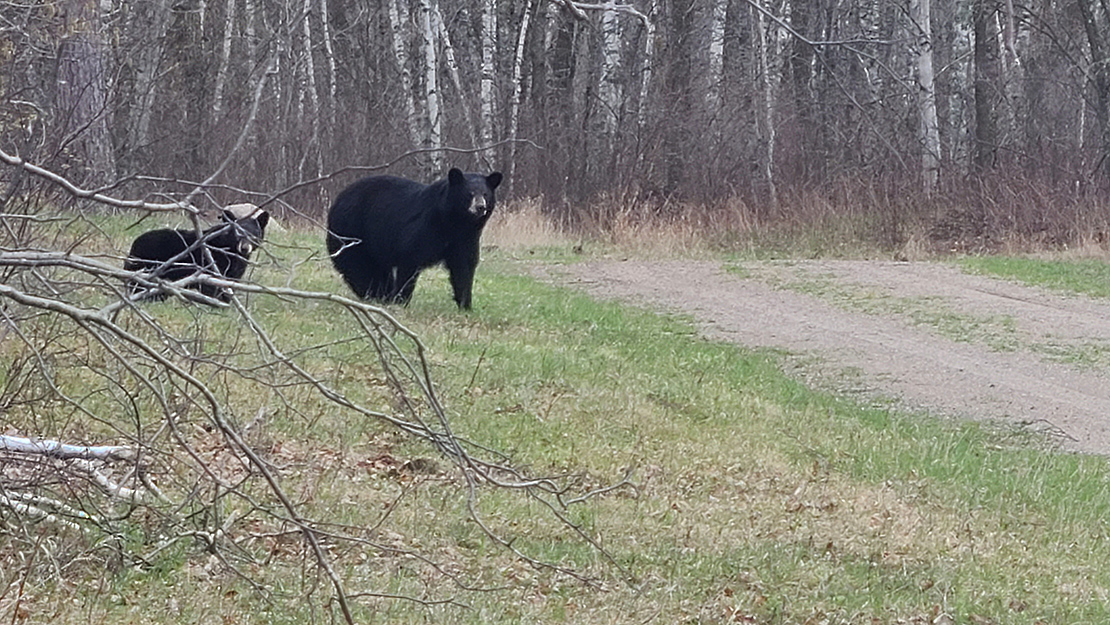
Camp Ripley’s believe it or not!
CAMP RIPLEY — Ray Nagengast, a disabled veteran and American Legion member of Buffalo Post 270, was one of the 34 disabled veterans who signed up as hunters for the 20th Veterans with Disabilities Turkey Hunt.
It began on a beautifully sunny Tuesday, April 30, at Camp Ripley. Warm weather after days of clouds and cold rain had everyone itching to get through the instructional class and out on the range.
“I love to do this because it is a good time to get out in the woods,” Nagengast said.
Assisting Nagengast was Steve Hanson of Detroit Lakes.
“It’s an honor to come and do this for these guys.”
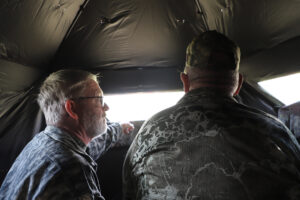
Hanson is the secretary for the Minnesota chapter of the National Wild Turkey Federation. I joined them on Tuesday afternoon when they first went out.
To set up a blind, it’s good to think about the position of the sun in the morning, he said. They like to get some sunshine, but they don’t like to look straight into a rising sun. In the spring, their main occupation is mating.
Turkeys have incredible eyesight and acute hearing. They can pinpoint the source of any sound. Hanson and Nagengast were assigned an area on the west edge of Camp Ripley. After patrolling for a quality spot along Luzon Road, they selected a clearing shaped like a sideways-T. We set up the blind close to the southeast corner of the junction, facing north and northwest. From here, we could see both directions.
Hanson set up the decoys, and I ran a string from the tom decoy to the blind. A handle on the line allows us to fan its tailfeathers.
Then we hid our vehicles behind a berm near the entrance. When we walked back to the blind, a hen ran across our path.
Hanson’s blind has a big back door, which makes it easy for getting in and out, like if the veteran is in a wheelchair. Not all of the disabled veterans at the hunt are in wheelchairs, though. Hanson walks, but it was clear he needs assistance with setting up and picking anything off the ground. He wouldn’t be hunting without Hanson’s help.
Of course, I knew the virtue of what we are doing. We are helping disabled veterans enjoy Minnesota’s great outdoors. But now, here I am, sitting in the blind, and his hat fell off. He can’t bend to reach it. I grabbed it and handed it to him.
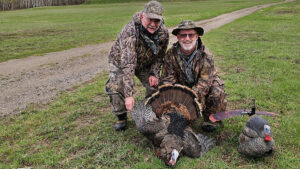
My thoughts turned to how amazing this is, to help this man, my fellow veteran, bag a bird. I contemplated this as we sat quietly, listening to the breeze.
Patience is key. Hanson said he calls every 20 minutes or so.
He started with a soft call. He used a mouth call. It’s like a half-potato chip a hunter bites on. The chip has a plastic reed allows him to mimic a hen’s call.
Twenty minutes later, he tried the box call. This is the classic wooden turkey caller, with a lid grinding against the box. It’s loud.
Finally, he uses a slate call. These calls may or may not have slate in them, but they all involve rubbing a peg against a surface that could be slate, glass, crystal, ceramic or aluminum. Sometimes, they are called pot calls. In terms of volume, it seems in between the other two.
“Every call works, and every call doesn’t work,” Hanson said.
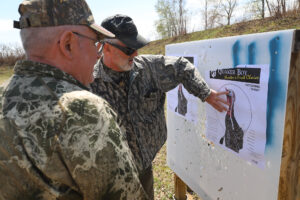
The box call worked this time. We heard gobbles.
And again. And again.
The tom expects the hen to come to him, Hanson said. However, when the hen doesn’t come, the tom often works his way closer to the hen in an attempt to connect.
Suddenly: c-c-c-crack! A tree or branch or something fell in the woods. It was followed by a quiet calm. Hanson tried the mouth call.
“Gobble.”
It sounds farther away now.
“Gobble gobble.”
He’s moving, that’s for sure. Hanson whispered there are factors we might not realize. Maybe the birds are afraid of a certain clearing because of a past coyote attack, for example.
We waited another five minutes.
“Gobble.”
The tom is even farther away. Hanson tried the slate call.
Nope. The tom had left the area.
The hunting time began around 1 p.m., lasts until 6:30 p.m., and I hadn’t planned to stay the whole time. Hanson opened the rear hatch, and we both stepped out to see the likely reasons the tom wandered away — a mama black bear and her cub were staring right at us.
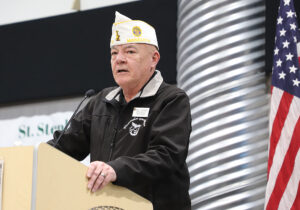
We stared right back in awe. Hanson reminded me to take some photos.
You probably wonder whether I was afraid. No, I wasn’t.
I reside in the metro these days, but I have lived most of my life in small towns or out in the country. When I lived in Washington state, we had bears there, too, and I explored the Cascade Range like crazy. I knew black bears rarely attack, especially when we don’t have dogs or food, so I wasn’t scared one bit. Mama seemed calm, and I snapped some photographs.
Hanson asked me to send the photos of the bears to him. I shook his hand, gathered my camera bag, and I walked to my car, occasionally looking back to check on the whereabouts of the bears.
His efforts to position themselves for a good morning hunt worked. Nagengast leveled his shotgun through an opening of the blind at 6:30 a.m. Wednesday, May 1, and shot a jake.
The Veterans with Disabilities Turkey Hunt is run by Minnesota Veterans Outdoors (mnvetsoutdoors.org), which is a collaborative program among the Minnesota levels of The American Legion, DAV, VFW, Paralyzed Veterans of America, Military Order of the Purple Heart, Elks, Camp Ripley Outdoor Adventures and Veterans 4 Veterans Trust Fund.
Late Tuesday evening, participants enjoyed a banquet in the Hangar Conference Center.
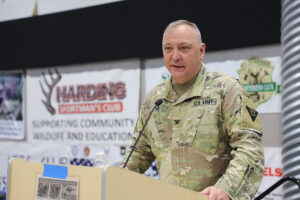
Col. Troy Fink, commander of Camp Ripley, led off. He thanked the veterans and volunteers. He said he loves the annual hunt, and he reminded people that events like this keep Camp Ripley busy.
“This place is humming pretty much every day,” he said.
Commissioner of Veterans Affairs Brad Lindsay noted his agency, the Minnesota Department of Veterans Affairs, will hold a commemorative event to mark 50 years since the Vietnam War at the Mall of America June 13-15, with special program at 11 a.m. June 14. He will be there with Gov. Tim Walz and Adj. Gen. Shawn Manke.
He gave an update on the dedications for the three new veterans homes. Montevideo is May 31. Preston is June 27. Bemidji is July 1. And he shared legislative measures passed last year and in play this session.
Tom Kramin is the coordinator for Minnesota Veterans Outdoors, and he is there on behalf of the Elks, which has programs to serve veterans. However, he is a member of Chanhassen American Legion Post 580, too.
He spoke about the other Minnesota Veterans Outdoors events: Trolling 4 Troops the first Friday of June and Disabled Veteran Deer Hunt the first week of October.
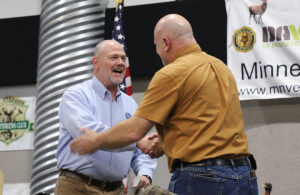
Department of Natural Resources Commissioner Sarah Strommen met Kramin at an ice-fishing event on Medicine Lake called Holes 4 Heroes.
She said helping veterans and their families enjoy the outdoors is part of the core values of the DNR.
Strommen told how she was really tired after a busy week, and, nevertheless, reluctantly got up early and went to a hunting event. As she was sitting in a blind at 7:15 a.m. she felt the weight of the world lift off of her shoulders.
“This is the best therapy. I was thankful that I didn’t give in to exhaustion,” she said. “It was healing. It was really powerful.”
Kramin responded, “That weight lifted off your shoulders is what we call ‘recreational therapy.’”
American Legion Department Commander Paul Hassing said the Legion, DAV and VFW tend to fight each other like brothers. However, they share many of the same values. With Minnesota having 280,000 veterans, and only 30 percent of them belonging to a veterans organization, there is work to be done to help veterans connect to their veteran communities.
“I just want you to join at least one of us. Our voice needs to be heard. The legislators told us they are not listening to us as much as they used to,” Hassing said. “We need to be heard as a collective.”
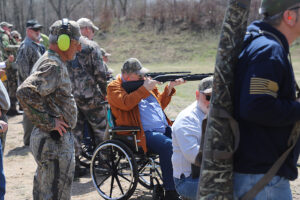
Hennepin County Veteran Service Officer Mike McElhiney was there on behalf of Minnesota Veterans 4 Veterans Trust Fund, a board that governs the funds received from the 2006 sale of Lake Minnetonka’s Big Island to the city of Orono for $5.7 million. The island had been owned by the Legion, DAV, MOPH and VFW and operated as a veterans’ camp. Now, V4V funds veteran programs such as recreational opportunities. For the turkey hunt, it covers all the lodging costs for the veterans and their guides.
New DAV of Minnesota Commander Oather Martin thanked the base for allowing the hunt and banquet to happen on base. He was an Army Ranger in Vietnam.
“Ever since I got back, I’ve been trying to help out my brothers and sisters,” he said.
How many birds were harvested?
Kramin said 15, one shy of the prior year.



